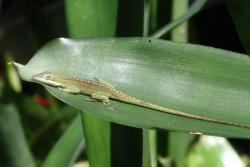I'm not sure how I made it to the museum today, but I did. I've been asleep for the better part of the last three days. I know I have chronic fatigue syndrome, but sometimes it just really hits me hard. Like today, I was in the flight cage and there was a family by the outside door. And I said the museum doesn't open until 10 am, but if they wanted to they could come in since I was there. So I spent about twenty minutes showing them the butterflies and caterpillars and educating. But man, by the time I was done I thought I was going to pass out! I went back in the lab, put the AC on full blast and just chilled out in a chair. So I didn't spend too long at the museum today, but I got some nice pictures. I released eighteen butterflies and we have a decent amount for this time of year, but the variety of species is quite limited.
I did get to release a few White Peacocks, including this one that flew off my hand as soon as the camera came out. It's like, suddenly they learn how to fly!
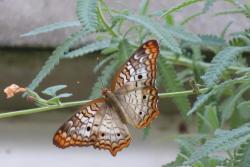
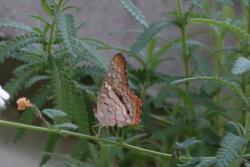
And we still have a good number of Malachites. Since the Atalas and Malachites are both South Florida butterflies, I wondered how they would react once we had cooler weather. The Atalas are nearly gone (we literally have one caterpillar) but the Malachites are still hanging in there with a pretty strong population. Here's a little trivia - the Malachites use two plants as hosts that are invasive exotics - the Mexican petunia and the Green Shrimp Plant. I thought the shrimp plant was native, but I was wrong. Both are in the Ruellia family, but I would suggest the native Carolina Petunia (Ruellia caroliniensis). The FSU website says Malachites will eat petunias and black-eyed susans so I say go with the native species. Seriously, those Mexican Petunias can get out of hand fast! And everyone around here grows them because Home Depot sells them and says, "They're so easy to grow!" But they don't tell you they're invasive. I've also had several people tell me theirs were nice for the first few years and then just looked really scraggly and didn't bloom like before.

Anyway, one more thing about host plants before I get to pictures...you can also use Ruellia for White Peacocks and Buckeyes, so it does triple duty! Also, funny story, I was reading the paper this week and there was an article about what gifts you can get for your pets (not kidding). Since I have fish, I smirked and thought, "Okay, tell me what my fish want for Christmas." And the article said why not try live, aquatic plants instead of the plastic plants. And it listed a few including lemon bacopa. And that's when the light bulb went on over my head. (We need that emoticon, FYI.) Lemon bacopa (not to be confused with other plants they call bacopa but aren't) is an aquatic plant and for a long time we had it growing in our water feature at MOSI. And I would straddle the middle of the stream and fish the caterpillars off the stalks while the guests looked at me like I'd lost my mind. I know I've never seen it for sale at a nursery, but I'm totally checking out the pet store next time I'm in there. "Why yes, I'm going to grow this for my caterpillars. The fish can totally keep the plastic plants."

Okay, here's some Malachite pictures. The family I talked to was really impressed how they look different on each side.
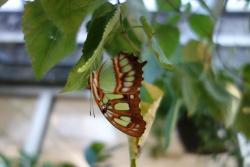
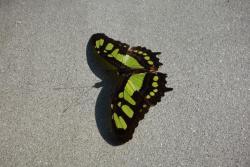
We still have a lot of Zebra Longwings and I released even more. This one looks like it's preparing for takeoff on the pipevine. You know how butterflies "taste" with their feet to find their host plant? I wonder if they ever sit on a plant and go "Yuck!" I mean, do they just know it's the wrong plant, or is it actually repellent in some way? I would think most plants would have to be okay because even when they nectar a lot of them sit on the leaves. Oh, if I could go inside the tiny mind of a butterfly...

Oh, and we had two pairs of Zebra Longwings mating in the flight cage. The mom of the family pointed one pair out to me, but I spotted this pair on the ceiling.
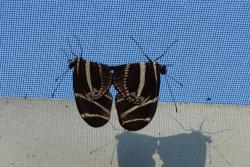
I didn't release any Julias today but there were plenty in the flight cage.
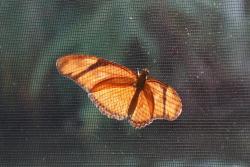
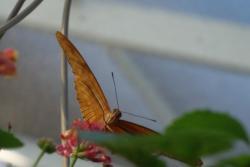
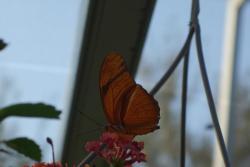
Back at the house, it was all Monarch cats. I did see a Gulf Frit flying around and a few Cassius Blues, but no one was stopping. So let's just look at some caterpillars! This one has thicker black stripes than most. I always think those are cool. This guy is in my actual butterfly garden.

But up front on the Giant Milkweed is where most of the action is. My caterpillars got very big, very fast. And we're going to reinforce the lesson that you can look for frass first, then let it lead you to the caterpillar. See the frass on the leaf? And who's behind there?
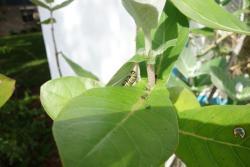
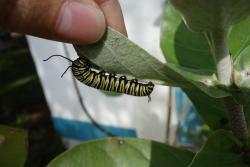
Look at the frass going down the leaves! And then we keep going down, turn over a leaf, and there he is!
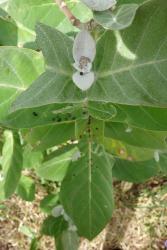
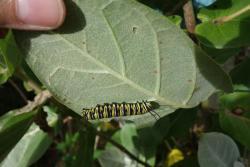
Even smaller caterpillars can be easy to find!
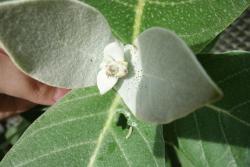

Unfortunately, sometimes you find those that didn't make it. Dead caterpillars attract predators so I highly recommend you get them off your plant! Just throw them to the ground and let the ants take care of it. The caterpillar might have been diseased so you don't want your other caterpillars to come in contact with it.

That last photo is too depressing to leave you with, so here's a native green anole I found on one of my bromeliads. That tail is super long! He must be a fast anole. Most of them seem like they're always missing a tail or in the process of growing it back. But look at this guy!
